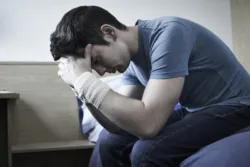Generalized Anxiety Disorder vs. Post-Traumatic Stress Disorder

It is normal for anyone to feel anxious. After all, our bodies exhibit a “fight or flight” response when we perceive a threat. Everyone’s response is different, and for some individuals, they may experience prolonged stress or anxiety.
Anxiety is very prevalent among U.S. adults ages 18 and older. Nearly 20% of adults have an anxiety disorder, such as panic disorder, generalized anxiety disorder, phobias, and social anxiety. Symptoms of anxiety disorders frequently overlap. It’s also common for individuals to have an anxiety disorder that co-occurs with another mental health disorder, such as post-traumatic stress disorder (PTSD).
Because PTSD and anxiety co-occur and share similar symptoms, it can be hard to distinguish between the two disorders.
Similarities Between PTSD and GAD
PTSD is classified as a trauma and stress-related disorder in the Diagnostic and Statistical Manual. Previously, it was considered to be one of the major types of anxiety disorders. PTSD can co-occur with generalized anxiety disorder (GAD). Trauma may exacerbate symptoms of GAD, or vice versa. GAD may also impact how an individual responds to a traumatic event.
Many signs of PTSD and GAD are similar, which can make it difficult to distinguish between the two disorders. These are some signs and symptoms that they share:
- Extreme worry
- Insomnia or restlessness
- Irritability and other changes in mood or thinking
- Difficulty concentrating
- Sweating
- Hypervigilance
- Avoidance of people, places, or things
- Symptoms cause significant impairment or distress in a person’s life
How PTSD and GAD Differ
The key differentiator between GAD and PTSD is the root cause of the disorder. PTSD develops in response to a traumatic experience. Trauma can occur in a few different ways:
- Direct exposure or experience
- Witnessing trauma
- Learning that trauma occurred to a close friend or family member
- Experiencing trauma through aversive details, often due to professional responsibilities (e.g., first responders)
In PTSD, symptoms begin or worsen after the traumatic experience. These symptoms are grouped into four categories:
- Intrusion symptoms: Recurrent memories, flashbacks, recurrent distressing dreams, or psychological distress when exposed to cues pertaining to the traumatic event
- Avoidance symptoms: Persistently avoiding external reminders of the event or trying to avoid thinking about the event
- Negative changes in mood and cognition: Dissociative amnesia, negative views of oneself or the world, self-blame, negative emotions, detachment, inability to experience positive emotions
- Arousal symptoms: Irritability or anger, self-destructive behavior, hypervigilance, difficulty concentrating, exaggerated startle response, difficulty sleeping
Again, you may recognize some symptoms of GAD in the diagnostic criteria for PTSD. However, GAD doesn’t include dissociative symptoms, which individuals who have PTSD often experience.
While fear or worry is common in PTSD and GAD, people with GAD experience persistent or excessive worry. That worry is not associated with a specific event, rather it typically occurs across a variety of events and circumstances.
Seeking Help
Post-traumatic stress disorder and generalized anxiety disorder can negatively impact people’s quality of life if not treated. Fortunately, treatment can help improve symptoms of both disorders and teach coping mechanisms.
Pyramid Healthcare provides outpatient treatment for individuals with mental health disorders. We also have dual diagnosis treatment centers for people who have co-occurring substance use disorders. Services are available for adults and adolescents.







